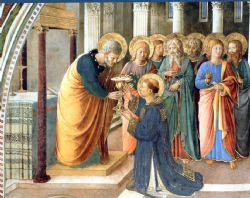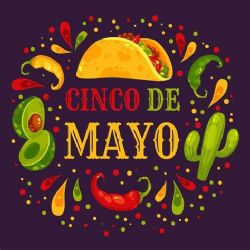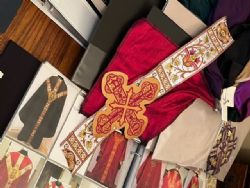Born in 1713 on the island of Majorca off the east coast of Spain, Miguel José Serra was ordained a Franciscan priest in 1737, taking the name Fr. Junipero Serra. At age 37, he landed in Mexico City, beginning the missionary work that would consume the rest of his life.
In 1768, Fr. Serra assumed control of recently abandoned Jesuit missions, 17 in all, of the Spanish territories that constitute a large portion of the present-day state of California. The Jesuits, after 65 years, were ousted by the Spanish government after rumors were spread that they were keeping riches acquired in California (gold, silver, pearls) and not sharing treasures with the king. Jesuit expulsion began three days after a delivery of the king's order on February 2, 1768. The Jesuits sailed from California to begin their exile back to Europe. Subsequent inventory of the abandoned missions revealed Jesuit abject poverty. Enter the Franciscans.
Serra was in large part responsible for the foundation and spread of the Church on the West Coast of the United States when it was still mission territory. He founded twenty-one missions and converted thousands of Indians. The converts were taught sound methods of agriculture, cattle raising, and arts and crafts. Fr. Junipero Serra died August 28, 1784, at the age of 70.
The El Camino Real (literally translated "The Royal Road," and often referred to as "The King's Highway") in 1769 was a footpath begun by the Franciscans north from San Diego to Sonoma, some 529 miles, along which twenty-one missions were founded. The length of the El Camino Real is variously described between 600 and 800 miles in length. The missions are roughly 30 miles apart, a long day's ride on horseback. Today, the El Camino Real is a designated National Historic Landmark.
In 1892, the California Federation of Women's Clubs in 1902 adopted an effort to preserve California's El Camino Real. The lack of standardized road signs at the time resulted in the placement of distinctive bells along the route, hung on supports in the form of an 11-foot (3.4 m) high shepherd's crook, also described as "a Franciscan walking stick". 
The bells were designed by Mrs. Armitage S. C. (Harrye) Forbes, owner of the California Bell Company where they were cast. Harrye Forbes, it turns out, had Kansas connections.
Born in Pennsylvania in 1861, Harrye Rebecca Piper Forbes (née Smith) moved with her family to Wichita, KS, in the 1870s. One of at least nine children, she graduated from Wichita Episcopal College and, in 1868, married English businessman, A.S.C. Forbes (not of Forbes Magazine fame). She became an historical preservationist, journalist, and author.
 Among her achievements was ownership of The California Bell Company, makers of the first of 450 bells of the El Camino Real, which was unveiled on August 15, 1906, near Olvera Street in Los Angeles. Each bell was inscribed with, "El Camino Real 1769-1906," the dates reflect the founding of the first Mission in 1769 and the dedication of the first bell in Los Angeles in August 1906.
Among her achievements was ownership of The California Bell Company, makers of the first of 450 bells of the El Camino Real, which was unveiled on August 15, 1906, near Olvera Street in Los Angeles. Each bell was inscribed with, "El Camino Real 1769-1906," the dates reflect the founding of the first Mission in 1769 and the dedication of the first bell in Los Angeles in August 1906.
Between 1914 and 1955, The California Bell Company made 9 ½" replicas of the original El Camino Real bells (original bronze casting bell weight estimate at 100 pounds!). The "El Camino Real Mission Guidepost Desk Bell" was cast of patina bronze and can be found online. The Serra Club of Johnson County happens to have in its possession eighteen of these bells. "How might this have happened?" one may ask. I asked myself!
In search of the answer, my wife and I spent a lovely evening at the Ray and Jennifer Zielinski home, seeing and hearing what they knew about the bells, as Ray had mentioned the bells at a recent Serra Club board meeting. They related that they had been given the collection by Fr. Francis Hund a few years ago, indicating further they had no knowledge of how Fr. Francis had come into possession of them. Ray recalled that it was Fr. Francis' desire that the bells should be connected to the Serra Club mission.
Fr. Francis agreed to meet after 0615 AM Mass on a Monday morning in the church narthex at Prince of Peace. He led me to a conference room just inside the school where we got acquainted and spoke about the bells. He related that he had been given the bells in 2010 or 2011 by long-time Curé of Ars parishioner, Mr. Florent Wagner. Uncertain as to Mr. Wagner's current whereabouts, Fr. Francis indicated that Mr. Wagner, "lived for years across the parking lot behind Curé of Ars."
Fr. Francis related a narrative of his visits to the El Camino Real, and his desire to return in the not-too-distant future. He described the beauty he encountered at various missions he has visited. Fr. Francis kept the bells in his possession until about 2017, when he was preparing to leave Nativity and recognizing the need to downsize. Keeping one bell in his possession, Fr. Francis entrusted the remaining bell collection to the Zielinskis, parishioners at Nativity and members of the Serra Club of Johnson County. Our delightful conversation came to an end all too soon. I thanked Fr. Francis for his time.
I found Florent Wagner in the White Pages and placed a call to his residence on a Thursday morning. I was greeted by a message recorded in Mr. Wagner's voice, asking me to leave my name, number, and a brief message. Mr. Wagner returned the call a few hours later, from his post as docent of the Overland Park Historical Society Museum on west 79th Street, at the northwest corner of old town Overland Park, where he spends every weekday afternoon from 1 PM to 5 PM. He indicated his willingness to meet. As only God can do, it so happened that I had a two-hour hole in my workday. Mr. Wagner said, "Come on over. I will be here."
I grabbed pen and pad and headed to Overland Park.
The next 45 minutes blew by. Mr. Wagner was gracious in relating his story. Several stories, actually. Never married, he grew up a collector. A collection of bells happens to be one his biggest. He also collects clocks and music boxes. He estimated that he purchased the El Camino Real bells individually "at antique shows, rummage sales, estate sales, wherever one appeared, between about 1954 and 1990."
"I bought them wherever I could find them," adding, "my mother was a collector and started taking me to antique shows when I was about three years old."
Conversation turned momentarily to an old cream separator in the window of the museum. I pointed out to Florent that I remembered my maternal grandmother operating a cream separator on the farm when I was a kid. She had a Guernsey cow she milked twice every day.
"Okay," he began thoughtfully, "very few people come in who actually know what that is." He launched into the value of the Guernsey cow to the dairy industry, remarking that the dairy industry was big in Kansas City, KS. He asked about my family and northeast Kansas, and we soon connected insofar as his mother's family included a very common name in my hometown community of Seneca, KS. He had been there. I described my home communities (the Seneca/St. Benedict area) as German Catholic communities, "with a few of us Czechs sprinkled around the area."
"Well, there were Czechs who were good Catholics, too!" his wit now shining. The world got smaller. We covered so much more ground than I can relate here. A history buff, Wagner experienced part of the El Camino Real during a family vacation as a youth. He recalled being at a couple of the California missions. His dream for his bell collection was to build a model/map of California, placing a bell on the map locating each of the twenty-one missions founded by Fr. Junipero Serra and the Franciscans. Raised a Catholic, he has been a parishioner at Curé of Ars for 54 years, and a member of the Serra Club of Kansas City, Kansas for "about 35 years." He began volunteering after retirement. "I retired at 48," he said, adding flatly, "that was a mistake!"
Wagner grew up in Kansas City, MO. His home parish was St. Thérèse the Little Flower, at 58th and Euclid. He described both of his parents having grown up in religious families. "Grandma Wagner was a very religious person." He appreciates having learned "the rules and regulations" along with the effort his parents made at instilling a faith life in him and his brother. Two of his aunts were religious sisters. Wagner graduated from law school in 1960 and went into legal work in the banking industry. "It paid $25 bucks more a month than law firms did. I thought I was floating in the clouds."
When informed that the trail of the El Camino Real bells led to him, he responded with his wry sense of humor, "Well, I'll see if I can direct it elsewhere."
Florent spoke from the heart about the importance of his Catholic faith, indicating that he has the Serran prayer for vocations memorized, saying it regularly for vocations. "Every time I get a bill from Serra, I remember to say it, for sure!" he quipped with a smile. He lamented the fact that health issues and his daily afternoon work at the museum kept him from being involved as much as he might like. "I keep paying the membership even though I don't get there," he added once again with his now-familiar humor. 
When asked about priests important in his life, he mentioned three: Fr. McKenna and Msgr. Koch of St. Thérèse Parish during his early life. "I wrote a biography of Msgr. Koch when I was in school there." He included Fr. Richard Story, Pastor of Curé of Ars, with whom he enjoys an occasional lunch. "Priests are probably the most important part of our lives, at least my life," he stated.
The gift of the encounter was entirely mine. I learned once again about the joy that exists in every soul, waiting to be tapped. Before I departed, I asked if I could snap a picture for the article.
"The way I look?" He smiled again, his eyes twinkling.
All because of a collection of small bells forged in the image of great bells along the El Camino Real. God draws us all together in ways only He can direct. The Zielinskis. Fr. Francis. Florent Wagner. All of us.
We are for whom the bells toll.




